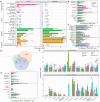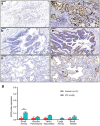This is a preprint.
Chronic lung diseases are associated with gene expression programs favoring SARS-CoV-2 entry and severity
- PMID: 33106805
- PMCID: PMC7587778
- DOI: 10.1101/2020.10.20.347187
Chronic lung diseases are associated with gene expression programs favoring SARS-CoV-2 entry and severity
Update in
-
Chronic lung diseases are associated with gene expression programs favoring SARS-CoV-2 entry and severity.Nat Commun. 2021 Jul 14;12(1):4314. doi: 10.1038/s41467-021-24467-0. Nat Commun. 2021. PMID: 34262047 Free PMC article.
Abstract
Patients with chronic lung disease (CLD) have an increased risk for severe coronavirus disease-19 (COVID-19) and poor outcomes. Here, we analyzed the transcriptomes of 605,904 single cells isolated from healthy and CLD lungs to identify molecular characteristics of lung cells that may account for worse COVID-19 outcomes in patients with chronic lung diseases. We observed a similar cellular distribution and relative expression of SARS-CoV-2 entry factors in control and CLD lungs. CLD epithelial cells expressed higher levels of genes linked directly to the efficiency of viral replication and innate immune response. Additionally, we identified basal differences in inflammatory gene expression programs that highlight how CLD alters the inflammatory microenvironment encountered upon viral exposure to the peripheral lung. Our study indicates that CLD is accompanied by changes in cell-type-specific gene expression programs that prime the lung epithelium for and influence the innate and adaptive immune responses to SARS-CoV-2 infection.
Keywords: COPD; COVID-19; genomics; pulmonary fibrosis; scRNA-seq.
Conflict of interest statement
Competing interests JAK has received advisory board fees from Boehringer Ingelheim, Inc, Janssen Pharmaceuticals, is on the scientific advisory board of APIE Therapeutics, and has research contracts with Genentech. In the last 36 months, NK reported personal fees from Biogen Idec, Boehringer Ingelheim, Third Rock, Samumed, Numedii, AstraZeneca, Life Max, Teravance, RohBar, and Pliant and Equity in Pliant; collaboration with MiRagen, AstraZeneca; Grant from Veracyte, all outside the submitted work. In addition, NK has a patent for New Therapies in Pulmonary Fibrosis, and Peripheral Blood Gene Expression licensed to Biotech. AGN has received advisory board fees from Boehringer Ingelheim, Galapagos, Medical Quantitative Image Analysis and personal fees for educational material from Up to Date and Boehringer Ingelheim. RGJ reports grants from AstraZeneca, grants from Biogen, personal fees from Boehringer Ingelheim, personal fees from Chiesi, personal fees Daewoong, personal fees from Galapagos, grants from Galecto, grants from GlaxoSmithKline, personal fees from Heptares, non-financial support from NuMedii, grants and personal fees from Pliant, personal fees from Promedior, non-financial support from Redx, personal fees from Roche, other from Action for Pulmonary Fibrosis, outside the submitted work.
Figures




References
Publication types
Grants and funding
LinkOut - more resources
Full Text Sources
Miscellaneous
